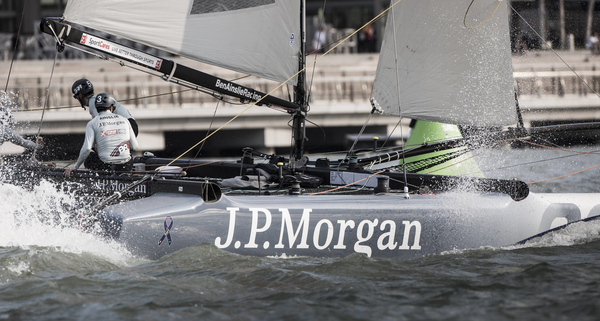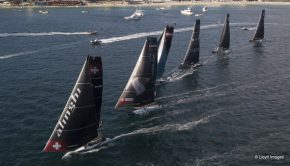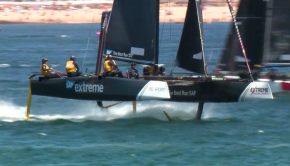Ben Ainslie Racing: Racing While Hydrated
Published on March 12th, 2014
(March 11, 2014) – Alex Hopson works closely with BAR – Ben Ainslie Racing – as their Trainer and Physio. Here he focuses on how the team trains for the Extreme Sailing Series.
Tell us about BAR’s training schedule?
The guys have to keep training outside of the Extreme Sailing Series events and with a busy schedule they have to be very smart and focused with their training. It can be easy to do a lot of training that has little effect on actual performance so the key is to train on the specifics that will give the sailors the physical characteristics to allow them to perform on the water. One of the challenges of working with sailing athletes is that sometimes athletic performance on the land does not reflect performance on the water – because of the massive demands on strategic and tactical skill.
We are quickly learning from the Extreme 40 Series, with tight racecourses and lots of boat handing skills, that the fitness element will be really import in order to do well during the Series.
Is there different training for the different roles on-board?
There are different demands for different roles on the boat. In light winds the trimmer (Nick) and bowman (Matt) have the majority of the physical work to do whilst it is important for other crew members to have good agility and flexibility to move around the boat as smoothly as possible to keep the boat moving fast. However, it doesn’t take much breeze before everyone on the boat is working hard in order to maximize the speed of the boat and to carry out manoeuvres on the very tight racecourses.
Why is it so important to keep hydrated during racing?
Environment factors can affect the body’s capability to stay hydrated. The body sweats in order to dissipate heat, during exercise heat production from your body can be as much as 15-20 times of that when resting. When the environment factors of heat in venues like Singapore and Oman are so great it places a greater demand on the body to dissipate heat and it is key to replace these fluids.
How can it affect a sailor’s performance if they don’t stay hydrated?
As little as a 2% drop in hydration can affect an athlete’s strength and physical endurance as well as cognitive function, which is extremely important in the tight and fast racing.
People assume drinking more and more water is the key – why is it important to use a supplement such as SOS Rehydrate?
It is important for performance that the athletes are using the right supplements at the right time. The demands that are placed on them can be massive overload and in order to continue to perform it is important to supplement the normal diet and hydration strategies of each athlete depending on their needs. In hot climates and when the athlete is being asked to work hard, hydration is key in order to retain fluids.
SOS is a great product and helps with our hydration strategies, the sodium content of the drink stimulates kidney function in order to retain water so that the fluid balance of the body and key electrolytes are retained. The sodium content also maintains the thirst of the athlete so that during the long periods of activity they can continue to take fluids. But above all other leading sports drinks contains seven times more carbohydrates in the form of sugar so it provides substantial rehydration without unnecessary excess sugar.
How many calories do the sailors burn between races?
During a race day, which can be up to eight races, the sailors will burn around an additional 5000 calories. Due to the restraints that long days on the water have on eating it is important that the right nutritional strategies are in place in order to consume this amount of calories to make sure that performance is not compromised over the 4 days of racing.
How does this style of racing compare physically to other World Series events?
The short racecourses and the importance of boat handing make the physical demands high. It is important that the athletes are able to stay strong and powerful for manoeuvres, but also with the ability to back this up race after race and day after day so the endurance of the athletes are also important.
Which of the events do you think will be the trickiest physically for the team?
I think that each event will throw different challenges for the crew depending on how the racing is adapted for each venue; I know that nature of the racing will always be tight! I think Singapore and St. Petersburg will be some of the tightest venues, but we are more likely to have lighter winds across the series – but we will have to see and be prepared for every condition!
Source: Team media
Background: The Extreme Sailing Series is in its eighth season, with this year’s eight event tour travelling through Asia and Europe. The platform used is the one design Extreme 40 catamaran, with the format for event including both ocean and ‘stadium’ short-course racing in front of the public. Interest in the ESS has grown in part due to the multihull format being used in the America’s Cup. ESS website: http://www.extremesailingseries.com/









 We’ll keep your information safe.
We’ll keep your information safe.